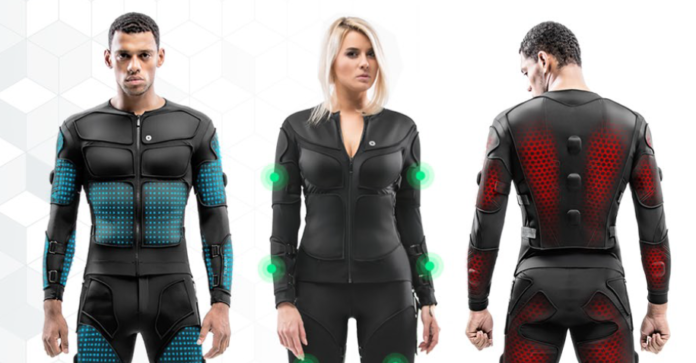Imagine taking a stroll through the world of Skyrim. Not just using wands and walking around, but actually feeling the cool windy air. In combat, you would feel the impact blocking strikes with your shield or swinging your sword.
That’s the dream of the Teslasuit: new haptic technology returning to CES.
This incredible technology is a full-body tailor-made suit designed to increase the user’s immersion in VR/AR. It’s an incredible piece of equipment that has promise as our future gymwear of choice.
Here’s a rundown of what it does and how the system works.
Fitness Boosting Technology
Imagine if your gym clothes could keep you cool, track your heart rate and correct your form when you workout. That’s the promise of the Teslasuit in a nutshell.

The Teslasuit is climate controlled, making it comfortable and durable wear with built in biometrics lining the suit. It’s a two-piece consisting of a jacket and pants, and it’s also lined with sensors that perform motion capture. It’s form fitting and it looks a little bulky.
Ideal for VR but maybe a bit restrictive for TaiChi class.
Climate control is crucial for nearly any aerobic exercise. Coupled with hydration, overheating puts a strain on overall endurance. It’s also a common deterrent for a workout and huge problem to overcome in climates with higher temperatures. Heat stress can actually kill your potential to hit your maximal metabolic rates when you’re trying to push yourself.
Data Collection and Application
The Teslasuit has more than built in air conditioning powering this piece of modern technology. Electrical Muscle Stimulation, or EMS, is also working behind the scenes to improve training and fitness potential. It’s complicated science, but the suit uses EMS to promote muscle bulking. The company argues that the Teslasuit can enhance muscle function over a 16-week period.
EMS can even assist in muscle soreness after training, like massage therapy. The company behind the suit thinks that it’s ideal for training in cycling, rowing, and climbing especially.

The suit also utilizes motion capture technology for an instructive approach to training.
Consider how a runner suffers from impact over time. Incorrect footing can create unnecessary strain all over the legs and knees. Coaches usually show the runner slow motion footage to help the person understand how their feet are working and how to correct that behavior. With the Teslasuit, the user can feel real-time adjustments from the suit along with feedback and biometrics that indicate when the technique was properly applied.
Theoretically, the Teslasuit and VR could detect and correct this kind of behavior. If the device can shift and correct the runner in real time, the user eventually learns to apply mid or forefoot running techniques.
Apps and Packaged Technology
The Teslasuit isn’t ready for mass consumption, that’s the bad news. But the design looks near finalized and developers are encouraged to work with it. The haptic and motion capture system create an alluring proposition to developers.
The demo at CES has users manipulating a spacecraft to dock with the ISS and deliver some supplies. It uses shock and force feedback to tell users when they collide with objects in the zero gravity environment. It’s not hard to imagine this collision system employed by an app like BoxVR or Beatsaber, making you feel every missed opportunity.
Who doesn’t love laser tag or paintball? Now imagine that in VR through the haptic suit, with actual hit detection. That’s the low hanging fruit, though.
The Hardlight Haptic Suit, a rival geared more toward gaming, is already compatible with both Holopoint, Sairento, and 16 other games. Haptics can help correct your form when you squat just as well as simulating a kick to the chest.
Why Haptics Matter

One word: immersion. Remember Skyrim? Now think about how raw and visceral combat will feel with haptics simulating the strain of every strike or riposte. Think about how this casual walk through an incredible land becomes an adrenaline pumping fight for survival.
But Haptic suits are more than just simulating a punch to the gut. They play an important role in rehabilitation. The Teslasuit’s based on rehabilitating athletes and stimulating muscle groups using the light-impact workout potential of VR. Its board includes medical doctors.
The suit is constantly collecting and transmitting biometrics as well. All of these technological developments point to a holistic view of the future athlete. Not just physical and mental health, but form and stamina over time. Coaches can track injuries and rehabilitation, and use VR to train athletes with real feedback for actions that lead to failure.
Hopefully, the Teslasuit helps to usher in an era of technology that meets this ambitious promise.











